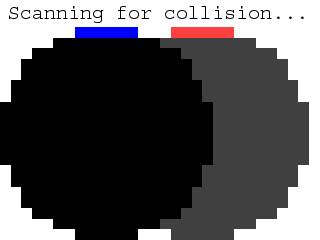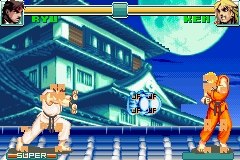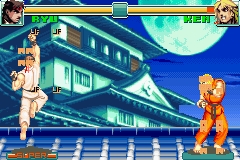Per Pixel Collision

Last Updated 3/30/14
You've already learned how to check collision with rectangles. Of course not everything in video games is a rectangle and there's often a loss of accuracy when dealing with non rectangular shapes. Here you'll learn to get collision accuracy down to the pixel.A Per-Pixel Collision Detection tutorial with SDL 2 is now available.
Everything is made out of rectangles, even this circle:

Don't see it? Let's magnify it:

Still don't see it? How about now:

Every image on a computer is made out of pixels, and pixels are squares which happen to be rectangles. So when you're checking collision between any shapes, you check if the two groups of rectangles have collided.

Don't see it? Let's magnify it:

Still don't see it? How about now:

Every image on a computer is made out of pixels, and pixels are squares which happen to be rectangles. So when you're checking collision between any shapes, you check if the two groups of rectangles have collided.
#include "SDL/SDL.h"
#include "SDL/SDL_image.h"
#include <string>
#include <vector>
In this program we include the vector library along with our other standard ones.
Vectors are kind of like arrays that are easier to manage.
//The dot
class Dot
{
private:
//The offsets of the dot
int x, y;
//The collision boxes of the dot
std::vector<SDL_Rect> box;
//The velocity of the dot
int xVel, yVel;
//Moves the collision boxes relative to the dot's offset
void shift_boxes();
public:
//Initializes the variables
Dot( int X, int Y );
//Takes key presses and adjusts the dot's velocity
void handle_input();
//Moves the dot
void move( std::vector<SDL_Rect> &rects );
//Shows the dot on the screen
void show();
//Gets the collision boxes
std::vector<SDL_Rect> &get_rects();
};
Here we have a revised version of the dot class.
We have the offsets and velocities from before, and now we have a vector of SDL_Rects to hold the dot's collision boxes.
In terms of functions, we now have shift_boxes() which moves the boxes in relation to the offset. I'll explain what that means later.
There's also the constructor which sets the dot at the offsets in the arguments and we have our event handler, move() and show() functions from before. We also have get_rects() which gets the dot's collision boxes.
We have the offsets and velocities from before, and now we have a vector of SDL_Rects to hold the dot's collision boxes.
In terms of functions, we now have shift_boxes() which moves the boxes in relation to the offset. I'll explain what that means later.
There's also the constructor which sets the dot at the offsets in the arguments and we have our event handler, move() and show() functions from before. We also have get_rects() which gets the dot's collision boxes.
bool check_collision( std::vector<SDL_Rect> &A, std::vector<SDL_Rect> &B )
{
//The sides of the rectangles
int leftA, leftB;
int rightA, rightB;
int topA, topB;
int bottomA, bottomB;
//Go through the A boxes
for( int Abox = 0; Abox < A.size(); Abox++ )
{
//Calculate the sides of rect A
leftA = A[ Abox ].x;
rightA = A[ Abox ].x + A[ Abox ].w;
topA = A[ Abox ].y;
bottomA = A[ Abox ].y + A[ Abox ].h;
//Go through the B boxes
for( int Bbox = 0; Bbox < B.size(); Bbox++ )
{
//Calculate the sides of rect B
leftB = B[ Bbox ].x;
rightB = B[ Bbox ].x + B[ Bbox ].w;
topB = B[ Bbox ].y;
bottomB = B[ Bbox ].y + B[ Bbox ].h;
//If no sides from A are outside of B
if( ( ( bottomA <= topB ) || ( topA >= bottomB ) || ( rightA <= leftB ) || ( leftA >= rightB ) ) == false )
{
//A collision is detected
return true;
}
}
}
//If neither set of collision boxes touched
return false;
}
Here we have our collision detection function.
In takes in two vectors of SDL_rects, then checks collision between the two sets of rectangles.
This function gets a rectangle from vector A, then checks if it collides with any rectangles from vector B, then gets another rectangle from vector A, then checks if it collides with any rectangles from vector B and so on until either a collision is found or all the rectangles have been checked.
So when the function is checking for collision it would operate like this:

Like from last time, the function returns true if there's a collision and false if there is no collision.
In takes in two vectors of SDL_rects, then checks collision between the two sets of rectangles.
This function gets a rectangle from vector A, then checks if it collides with any rectangles from vector B, then gets another rectangle from vector A, then checks if it collides with any rectangles from vector B and so on until either a collision is found or all the rectangles have been checked.
So when the function is checking for collision it would operate like this:

Like from last time, the function returns true if there's a collision and false if there is no collision.
Dot::Dot( int X, int Y )
{
//Initialize the offsets
x = X;
y = Y;
//Initialize the velocity
xVel = 0;
yVel = 0;
//Create the necessary SDL_Rects
box.resize( 11 );
//Initialize the collision boxes' width and height
box[ 0 ].w = 6;
box[ 0 ].h = 1;
box[ 1 ].w = 10;
box[ 1 ].h = 1;
box[ 2 ].w = 14;
box[ 2 ].h = 1;
box[ 3 ].w = 16;
box[ 3 ].h = 2;
box[ 4 ].w = 18;
box[ 4 ].h = 2;
box[ 5 ].w = 20;
box[ 5 ].h = 6;
box[ 6 ].w = 18;
box[ 6 ].h = 2;
box[ 7 ].w = 16;
box[ 7 ].h = 2;
box[ 8 ].w = 14;
box[ 8 ].h = 1;
box[ 9 ].w = 10;
box[ 9 ].h = 1;
box[ 10 ].w = 6;
box[ 10 ].h = 1;
//Move the collision boxes to their proper spot
shift_boxes();
}
Now here's the dot's constructor.
It sets the dot's offsets to the arguments given, and initializes the velocity of the dot.
Then we create 11 collision boxes in the vector and set them like this:

At the end we set the boxes relative to the dot's offset.
It sets the dot's offsets to the arguments given, and initializes the velocity of the dot.
Then we create 11 collision boxes in the vector and set them like this:

At the end we set the boxes relative to the dot's offset.
void Dot::shift_boxes()
{
//The row offset
int r = 0;
//Go through the dot's collision boxes
for( int set = 0; set < box.size(); set++ )
{
//Center the collision box
box[ set ].x = x + ( DOT_WIDTH - box[ set ].w ) / 2;
//Set the collision box at its row offset
box[ set ].y = y + r;
//Move the row offset down the height of the collision box
r += box[ set ].h;
}
}
You may be asking yourself what I mean by "Setting the boxes relative to the dot's offset".
Say if you move the dot 100 pixels over, but when it goes over the other dot it doesn't detect the collision.
The reason for this is that when you move the dot, you have to move collision boxes along with it and that's what this function does.
Don't worry how I did it, it was just a fancy way of doing:
box[ 0 ].x = x + 7;
box[ 0 ].y = y;
box[ 1 ].x = x + 5;
box[ 1 ].y = y + 1;
and so on.
Say if you move the dot 100 pixels over, but when it goes over the other dot it doesn't detect the collision.
The reason for this is that when you move the dot, you have to move collision boxes along with it and that's what this function does.
Don't worry how I did it, it was just a fancy way of doing:
box[ 0 ].x = x + 7;
box[ 0 ].y = y;
box[ 1 ].x = x + 5;
box[ 1 ].y = y + 1;
and so on.
void Dot::handle_input()
{
//If a key was pressed
if( event.type == SDL_KEYDOWN )
{
//Adjust the velocity
switch( event.key.keysym.sym )
{
case SDLK_UP: yVel -= 1; break;
case SDLK_DOWN: yVel += 1; break;
case SDLK_LEFT: xVel -= 1; break;
case SDLK_RIGHT: xVel += 1; break;
}
}
//If a key was released
else if( event.type == SDL_KEYUP )
{
//Adjust the velocity
switch( event.key.keysym.sym )
{
case SDLK_UP: yVel += 1; break;
case SDLK_DOWN: yVel -= 1; break;
case SDLK_LEFT: xVel += 1; break;
case SDLK_RIGHT: xVel -= 1; break;
}
}
}
Here's the dot's event handler.
As you can see the dot's velocity is only one pixel per frame so if you notice it's going slow just know its intentional.
If you can only move one pixel at a time you can better see the per pixel collision.
void Dot::move( std::vector<SDL_Rect> &rects )
{
//Move the dot left or right
x += xVel;
//Move the collision boxes
shift_boxes();
//If the dot went too far to the left or right or has collided with the other dot
if( ( x < 0 ) || ( x + DOT_WIDTH > SCREEN_WIDTH ) || ( check_collision( box, rects ) ) )
{
//Move back
x -= xVel;
shift_boxes();
}
//Move the dot up or down
y += yVel;
//Move the collision boxes
shift_boxes();
//If the dot went too far up or down or has collided with the other dot
if( ( y < 0 ) || ( y + DOT_HEIGHT > SCREEN_HEIGHT ) || ( check_collision( box, rects ) ) )
{
//Move back
y -= yVel;
shift_boxes();
}
}
Here's the dot's move function that we separated from the show function.
Its pretty much the same story as before. We move the dot, and if the dot went off the screen or over the vector of rectangles, move back. There is one key difference however.
Whenever we move the dot, we call shift_boxes() to move the collision boxes along with the dot. The collision boxes will do no good if they do not go along with the dot.
Its pretty much the same story as before. We move the dot, and if the dot went off the screen or over the vector of rectangles, move back. There is one key difference however.
Whenever we move the dot, we call shift_boxes() to move the collision boxes along with the dot. The collision boxes will do no good if they do not go along with the dot.
void Dot::show()
{
//Show the dot
apply_surface( x, y, dot, screen );
}
Here's our show function that applies the dot to the screen.
std::vector<SDL_Rect> &Dot::get_rects()
{
//Retrieve the collision boxes
return box;
}
Here's the function that gets the dot's collision boxes.
//Make the dots
Dot myDot( 0, 0 ), otherDot( 20, 20 );
In our main function we generate two Dot objects, "myDot" which is the dot we're moving and "otherDot" which is the dot that's sitting still.
//While the user hasn't quit
while( quit == false )
{
//Start the frame timer
fps.start();
//While there's events to handle
while( SDL_PollEvent( &event ) )
{
//Handle events for the dot
myDot.handle_input();
//If the user has Xed out the window
if( event.type == SDL_QUIT )
{
//Quit the program
quit = true;
}
}
//Move the dot
myDot.move( otherDot.get_rects() );
//Fill the screen white
SDL_FillRect( screen, &screen->clip_rect, SDL_MapRGB( screen->format, 0xFF, 0xFF, 0xFF ) );
//Show the dots on the screen
otherDot.show();
myDot.show();
//Update the screen
if( SDL_Flip( screen ) == -1 )
{
return 1;
}
//Cap the frame rate
if( fps.get_ticks() < 1000 / FRAMES_PER_SECOND )
{
SDL_Delay( ( 1000 / FRAMES_PER_SECOND ) - fps.get_ticks() );
}
}
Here's the main loop.
We handle events, move the dot, fill the screen white, show the dots, update the screen, and cap the frame rate.
Now you can check collision with whatever you want.
There is one note I want to make about per pixel collision.
Even though you can check for collision down the the pixel, 99% of the time you don't have to.
The perfect example of this is super street fighter 2 turbo.
If you have the GBA version, when you activate the akuma glitch you can see the corners of the collision boxes:




As you can see the collision detection is not down to the pixel.
When it comes to collision detection, down to the pixel accuracy isn't always needed. In many cases it's a waste of CPU power to check collision down to the pixel. There is such thing as accurate enough. It's up to you to decide how much accuracy you need.
The multiple collision box method should cover any type of overlap you can think of. For those of you that need even more advanced collision detection such as objects going at high velocities that don't overlap neatly, look up the "sweep tests" if you're comfortable with vector math.
The perfect example of this is super street fighter 2 turbo.
If you have the GBA version, when you activate the akuma glitch you can see the corners of the collision boxes:




As you can see the collision detection is not down to the pixel.
When it comes to collision detection, down to the pixel accuracy isn't always needed. In many cases it's a waste of CPU power to check collision down to the pixel. There is such thing as accurate enough. It's up to you to decide how much accuracy you need.
The multiple collision box method should cover any type of overlap you can think of. For those of you that need even more advanced collision detection such as objects going at high velocities that don't overlap neatly, look up the "sweep tests" if you're comfortable with vector math.